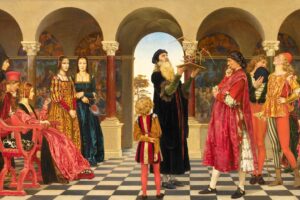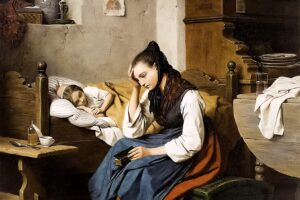Imagine the soft stillness of morning, when the world is just waking up and everything feels calm and unhurried. That gentle mood is exactly what Jean-Étienne Liotard captures in his painting A Dutch Girl at Breakfast, created in 1756. Known for his careful attention to detail and quiet elegance, Liotard invites us into a peaceful, private moment in everyday life.
A Graceful Scene
The young woman sits at a small round table, quietly preparing or enjoying her morning tea. She wears a modest but beautifully painted white dress with a light apron, and a soft cap covers her hair. Her expression is calm and focused, completely absorbed in her task. There’s no rush, no distraction—just quiet attention to a familiar routine.
- The Table Setting: A blue tabletop holds a neat arrangement: a tray with a teapot, cups, and a small bowl, likely for sugar. Everything is placed with care. The ribbon hanging over the edge adds a touch of softness, suggesting a recently opened package or napkin.
- The Warm Interior: The green walls and wooden furniture create a cozy, homely space. Behind her, a cabinet stands tall, and on the wall hangs a painting showing a sunlit architectural scene, adding depth and quiet contrast to the intimacy of the room.
- A Foot Warmer Below: A small foot stove at her feet—a charming detail—reminds us of the practical comforts needed during a cold morning, especially in 18th-century Dutch homes.
Peace and Simplicity
This painting doesn’t try to impress with luxury or grandeur. Instead, it gently honors the beauty of simplicity. Liotard’s skill lies in how he captures texture, light, and presence: the sheen of the dress, the quiet strength of the young woman’s posture, the careful arrangement of daily items. Each element contributes to a sense of peaceful dignity.
A Moment to Pause
A Dutch Girl at Breakfast is a portrait of quiet domestic life—unhurried, thoughtful, and deeply human. Through this painting, Liotard reminds us that there’s something meaningful in small, ordinary moments: making tea, sitting still, starting the day.
It’s an invitation to pause, notice the light, and appreciate the calm routines that quietly shape our lives.
About Artist

Jean-Étienne Liotard (1702–1789) was a Swiss-French painter, pastellist, and diplomat who was active throughout Europe. Although he lived and worked during the Rococo period, his style was notably different from the mainstream. Unlike the playful and sensual art of Boucher and Fragonard, Liotard’s work is celebrated for its sober realism, meticulous detail, and a commitment to capturing the exact likeness of his subjects without flattery.
Liotard’s unique style was a result of his extensive travels, including a five-year stay in Constantinople (modern-day Istanbul), where he adopted Turkish dress and a long beard, earning him the nickname “The Turkish Painter.” His work is a fascinating blend of the precise, detailed technique of the Northern European tradition and the exotic flair he acquired during his travels. He worked primarily in pastels, a medium that allowed him to capture delicate textures and subtle gradations of color with great precision.
Artwork Profile
All the paintings you mentioned are by Jean-Étienne Liotard and are excellent examples of his distinctive style.
- A Dutch Girl at Breakfast (c. 1756): Also known as La Belle Chocolatière, this is perhaps Liotard’s most famous work. It depicts a young maidservant carrying a tray with a glass of water and a porcelain cup of hot chocolate. The painting is celebrated for its remarkable realism, with Liotard meticulously rendering the textures of the silk apron, the glistening glass, and the subtle light playing on the girl’s face. The composition is simple and direct, a stark contrast to the flamboyant theatricality of other Rococo works.
- The Chocolate Girl: This is an alternate, and very common, title for A Dutch Girl at Breakfast.
- Portrait of Marie-Adélaïde of France in Turkish Dress (1753): This portrait showcases Liotard’s skill in combining his precise realism with the exoticism he was known for. It depicts the daughter of King Louis XV in a detailed and sumptuous Turkish costume.
- Still Life: Tea Set (c. 1781): This work highlights his mastery of still life. The meticulous detail in the porcelain and the reflections on the silver demonstrates his keen eye and precise technique.



